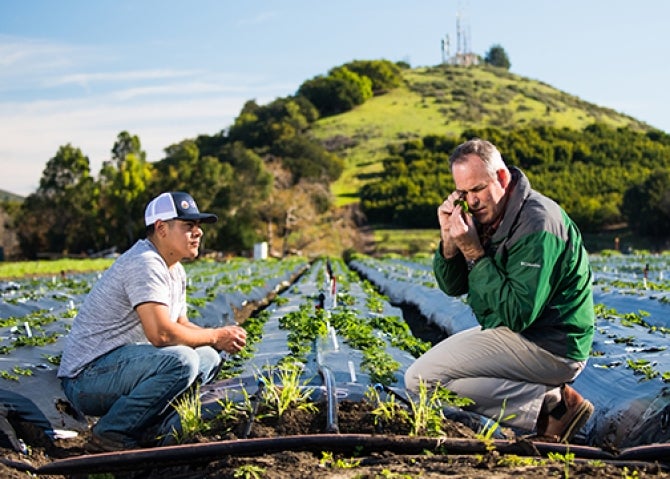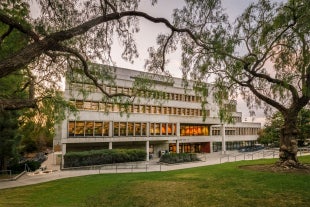Cal Poly Strawberry Center and U.S. Department of Agriculture Agricultural Research Service Receive Additional $1.25 Million in Federal Funding

Contact: AnnMarie Cornejo
805-756-2427; ancornej@calpoly.edu
SAN LUIS OBISPO, Calif. — The Cal Poly Strawberry Center, in collaboration with the California Strawberry Commission and the U.S. Department of Agriculture Agricultural Research Service (USDA ARS) in Salinas, California, has received $1.25 million in federal funding in continued support of its research in strawberry production automation and its efforts in fostering a workforce pipeline to support sustainable food production needed to meet the demands of a growing population.
Lawmakers increased the 2024 federal appropriation to $1.25 million from the initial $1 million awarded through the “Consolidated Appropriations Act, 2023” bill. The increase will be used by the USDA ARS to hire a dedicated lab technician to create a first-of-its-kind production automation program focused on non-chemical pest and disease management, as well as workforce efficiency and safety, said John Lin, who serves a joint appointment as both the California Strawberry Commission’s and the Cal Poly Strawberry Center’s director of automation engineering.
The program brings together farmers, entrepreneurs, researchers, educators and students to focus on development and deployment of innovative automation and mechanization technologies related to planting, pruning, pest management, picking and processing in the strawberry industry.
“The USDA is creating a new dedicated production automation program, and Cal Poly is supplying the engineering expertise to assist in structuring that program,” Lin said. “The Strawberry Commission engages growers, encouraging them to participate in the development of new technologies, and then provides outreach when these technologies become ready for implementation.”
According to Lin, this program will be farmer focused, with technologies created to be practical to implement, effective in solving the problem and valuable to the farmer and surrounding community.

“This collaboration directly benefits strawberry production in California and throughout the U.S. by linking the USDA Agricultural Research Service, the research arm of the USDA, with Cal Poly’s highly respected Strawberry Center and engineering program, to address the needs of the strawberry industry,” said Bill Wintermantel, research leader and location coordinator of the Sam Farr United States Crop Improvement and Protection Research Center. “The partnership will facilitate the development of new technologies to address production and pest management issues, while providing Cal Poly students with experience developing, testing, and evaluating automated technology-based approaches. The ability to work with Cal Poly students and faculty will strengthen the research conducted by USDA ARS, while providing opportunities for students to gain experience in applying technology to solve problems affecting strawberry production.”
The collaboration has a direct benefit to industry.
“The California Strawberry Commission and the Cal Poly Strawberry Center are committed to providing the strawberry industry with the innovation, information and support needed to ensure California Strawberry growers are ready for the future of farming,” said Rick Tomlinson, California Strawberry Commission president.
Through the partnership, the USDA ARS is providing dedicated strawberry fields, greenhouse space and lab facilities for experiments. The USDA ARS recently opened its cutting-edge, 100,000-square-foot agriculture research facility in Salinas, adding additional state-of-art greenhouse and laboratory facilities to the partnership.
The increased funding will also be used to support related programs at Hartnell College, a community college in Salinas, from which many students transfer to Cal Poly.
“We are all working together to bring greater value to automation in the strawberry industry,” said Gerald Holmes, director of the Cal Poly Strawberry Center. “This funding allows for a dedicated engineering team for production automation to ensure that we continue to advance groundbreaking technologies in the field. It also ensures that we are working with students and providing direct work experience from their first year of college.”
Said Rep. Salud Carbajal: “As a member of the House Agriculture Committee and the son of a Central Coast farmworker, I’m working in Congress every day to support our region’s largest industry, agriculture, and the cutting-edge research happening alongside it in our own backyard. Cal Poly’s partnership with USDA ARS is helping to put the Central Coast’s delicious fruits on the tables of more families across America, and I’m happy to see funding I worked to secure in our federal budget delivering the investments to keep that innovation on the front burner.”
Strawberries are California’s third highest-grossing crop, bringing in $2.68 billion in 2022. There are more than 400 growers, shippers and processors that grow 90% of U.S.-grown strawberries, many on multi-generational family-owned farms.
“Although our producers on the Central Coast of California continue to grow amazing strawberries, they always are looking to innovate to continue their success,” said Rep. Jimmy Panetta. “This significant federal investment will help usher in new automation, innovation and collaboration in how they sustainably grow strawberries, improve quality and compete in an increasingly competitive global market. The Cal Poly Strawberry Center represents the gold standard in agricultural research, and I look forward to continuing to ensure that the federal government plays its part to help with the Center’s groundbreaking work.”
Increased focus on automation technologies will help improve strawberry production and lead to a higher-quality product, supplying a steady stream of healthy produce. The introduction of advanced technologies, including automation capabilities, are critical to the long-term competitiveness for domestic production of strawberries and other specialty crops within the international agricultural marketplace.
The Cal Poly Strawberry Center’s engineering staff, composed primarily of Cal Poly graduates, serve joint appointments with the California Strawberry Commission, in addition to serving as advisors to Cal Poly’s BioResource and Agricultural Engineering (BRAE) Department’s senior capstone courses. In those courses, students fabricate projects that are then deployed for research and testing in the field. The new round of federal funding will provide the funds needed to hire a dedicated staff fabricator in the BRAE Department to focus on those projects.
One such project, an improved variation of the Lygus bug vacuum, is now being used by more than 60 percent of the industry since it was introduced two years ago. Over the last five years, the Strawberry Center has successfully developed and commercialized several additional types of enhanced strawberry production equipment such as an optimized spray rig, strawberry decapper, plastic hole puncher and hoop house disassembler.
This new funding will leverage the center’s proven method of developing transformative technologies that meet farmers’ needs with the USDA Agricultural Research Service’s world-leading strawberry production research to ensure California strawberries are sustainable and globally competitive. Research is currently being done in utilizing ultraviolet lighting for pest and disease management, as well as using technology for early detection of Lygus and mites in fields.
“The increased collaboration between Cal Poly and the USDA ARS is a welcomed partnership,” Holmes said, adding that California Strawberry Commission’s engagement with local industry allows all entities to better fulfill their purpose of furthering well developed, sustainable solutions to both current and future challenges.
“In the face of the climate crisis, devastating winter floods and an aging farm workforce, improving the safety and efficiency of strawberry production is crucial for sustainably supporting farmers,” Senator Alex Padilla said. “I am proud to have worked alongside Cal Poly and the California Strawberry Commission to facilitate this groundbreaking research that will bolster California’s agriculture industry.”
About Cal Poly’s College of Agriculture, Food and Environmental Sciences
Cal Poly is a nationally ranked, comprehensive polytechnic university. The university’s College of Agriculture, Food and Environmental Sciences is comprised of expert faculty members who take pride in their ability to transform academically motivated students into innovative professionals ready to solve the complex challenges associated with feeding the world in sustainable ways. Students have access to state-of-the-art laboratories, including organic and conventional crop land, orchards, vineyards, forests, and rangeland, all of which provide the basis for Cal Poly’s Learn by Doing methodology. It is the fifth-largest college of agriculture in the country with more than 4,100 undergraduate students. For more information visit CAFES.calpoly.edu.
About Cal Poly Strawberry Center
The Cal Poly Strawberry Center was established in 2014 within the Cal Poly College of Agriculture, Food and Environmental Sciences as a partnership between Cal Poly and the California Strawberry Commission. This one-of-a-kind center is rooted in the hands-on learning approach that defines Cal Poly. The center focuses on applied research incorporating teaching and learning experiences for Cal Poly undergraduate and graduate students, faculty and California strawberry farmers. For more information, please visit www.strawberry.calpoly.edu.


